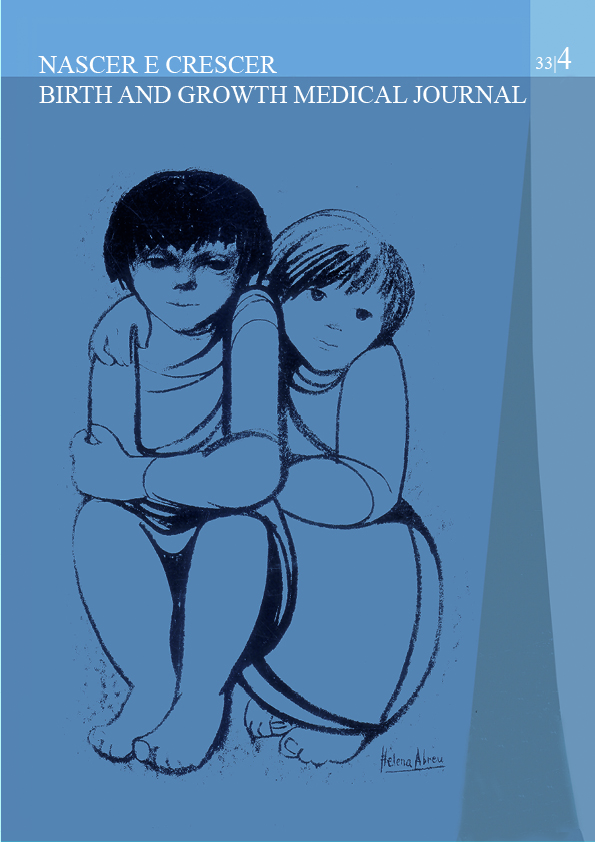Epiphyseal separation of the proximal humerus in a preterm newborn
DOI:
https://doi.org/10.25753/BirthGrowthMJ.v33.i4.28836Keywords:
epiphyseal separation, preterm neonate, proximal humerusAbstract
Introduction: Epiphyseal separation of the proximal humerus at birth is a rare injury and its diagnosis can be challenging.
Case report: A 28-week preterm newborn was delivered by emergency cesarean section. After a difficult extraction, the newborn presented with ecchymosis and swelling of the right shoulder and internal rotation of the right upper arm. Although the initial radiograph suggested shoulder dislocation, ultrasonography revealed epiphyseal separation of the proximal humerus.
Discussion: Due to the unossified epiphysis in neonates, radiographic findings of epiphyseal separation may be misinterpreted as normal. Ultrasonography provides a more reliable diagnostic tool, allowing early and accurate identification. Given the high remodeling potential of the proximal humerus, these injuries are typically managed conservatively and have an excellent prognosis.
Conclusion: This case highlights the importance of timely and accurate diagnosis of epiphyseal separation in newborns following traumatic birth. Prompt diagnosis allowed for conservative management of the patient, successfully preventing long-term sequelae.
Downloads
References
Cepela DJ, Tartaglione JP, Dooley TP, Patel PN. Classifications In Brief: Salter-Harris Classification of Pediatric Physeal Fractures. Clin Orthop Relat Res. 2016; 474: 2531-7.
Basha A, Amarin Z, Abu-Hassan F. Birth-associated long-bone fractures. International Journal of Gynecology and Obstetrics. 2013; 123: 127–30.
Costa JN, Costa JD, Macedo F, Rocha M, Lucas J, Cerqueira R, Lima F. Epiphyseal Separation of the Proximal Humerus in a Newborn. Acta Scientific Orthopaedics. 2023; 6: 21-4.
Varghese J, Teng M, Huang M, Balsam D. Birth Injuries to Growth Plates: A Sheep in Wolves’ Clothing. J Clin Ultrasound 2017, published online in Wiley Online Library.
Zieger M, Dorr U, Schulz RD. Sonography of slipped humeral epiphysis due to birth injury. Pediatr Radiol. 1987; 17: 425-6.
Jones G, Seguin J, Shiels WE 2nd. Salter-Harris II Fracture of the Proximal Humerus in a Preterm Infant. American Journal of Perinatology. 2003; 20: 249-53.
Guo JB, Zhang JD, Zhao YM, Yang Y. Fracture separation of the proximal humeral epiphyses in neonate: a case report and literature review. Chinese Journal of Traumatology. 2010; 13(1):62-4.
Sherr-Lurie N, Bialik GM, Ganel A, Schindler A, Givon U. Fractures of the humerus in the neonatal period. Isr Med Assoc J. 2011 Jun;13(6):363-5.
El-Adl WA, Elgohary HS, Elshennawy MM. Epiphyseal separation of the proximal humerus after birth trauma. Eur J Orthop Surg Traumatol. 2014 Aug;24(6):863-7. doi: https://doi.org/10.1007/s00590-013-1276-0.
Lefèvre Y, Journeau P, Angelliaume A, Bouty A, Dobremez E. Proximal humerus fractures in children and adolescents. Orthop Traumatol Surg Res. 2014 Feb;100(1 Suppl):S149-56. doi: https://doi.org/10.1016/j.otsr.2013.06.010.
Downloads
Published
How to Cite
Issue
Section
License
Copyright (c) 2025 Sara Rodrigues, Diana Reis Monteiro, Rosário M. Cunha, Inês Casais, Sandra Silva, Mafalda Santos

This work is licensed under a Creative Commons Attribution-NonCommercial 4.0 International License.
Copyright and Authors' Rights
All articles published in Nascer e Crescer - Birth and Growth Medical Journal are Open Access and comply with the requirements of funding agencies or academic institutions. For use by third parties, Nascer e Crescer - Birth and Growth Medical Journal adheres to the terms of the Creative Commons License "Attribution - Non-Commercial Use (CC-BY-NC)".
It is the author's responsibility to obtain permission to reproduce figures, tables, etc. from other publications.
Authors must submit a Conflict of Interest statement and an Authorship Form with the submission of the article. An e-mail will be sent to the corresponding author confirming receipt of the manuscript.
Authors are permitted to make their articles available in repositories at their home institutions, provided that they always indicate where the articles were published and adhere to the terms of the Creative Commons license.


